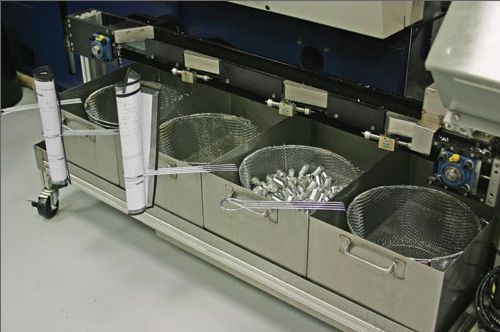Lights out Output
For lights-out machining, being able to efficiently backtrack from smaller batches if something goes wrong helps identify when an error occurred.

For lights-out machining, being able to efficiently backtrack from smaller batches if something goes wrong helps identify when an error occurred.
Everybody is trying to go lights out. It just makes sense to make parts virtually labor-free for a shift or two. So here’s a question: When you turn the lights on, what do you have? Well, hopefully you have a large quantity of good parts.
Usually, longer-running parts are delegated to untended machining. Consequently, at the end of the shift there are bins full of machined parts. Although I’m sure your shop has never experienced this, sometimes something happens in the machining process that causes the part to go out of spec sometime during the night.
The problem is figuring out when the incident occured and how many parts are affected. Short of inspecting the entire batch to find these renegade parts, there may be a simpler way to at least narrow the search. I came across one such device in a lights-out shop in Chicago that runs its eight-spindle Tornos untended. Of course, a multi-spindle makes a lot of parts quickly.
These guys came up with a programmable part separator, built in-house. Finished parts can be diverted to or four discharge baskets at programmed intervals. For lights-out machining, this nifty device allows the shop to backtrack from smaller batches if something goes wrong, and it helps identify when an error occurred.
Read the full story here.
Related Content
-
4 Steps to a Cobot Culture: How Thyssenkrupp Bilstein Has Answered Staffing Shortages With Economical Automation
Safe, economical automation using collaborative robots can transform a manufacturing facility and overcome staffing shortfalls, but it takes additional investment and a systemized approach to automation in order to realize this change.
-
Beyond the Machines: How Quality Control Software Is Automating Measurement & Inspection
A high-precision shop producing medical and aerospace parts was about to lose its quality management system. When it found a replacement, it also found a partner that helped the shop bring a new level of automation to its inspection process.
-
Which Approach to Automation Fits Your CNC Machine Tool?
Choosing the right automation to pair with a CNC machine tool cell means weighing various factors, as this fabrication business has learned well.







.png;maxWidth=300;quality=90)





